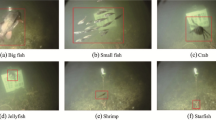Abstract
Training experiments were performed to investigate the ability of goldfish to discriminate objects differing in spatial depth. Tests on size constancy should give insight into the mechanisms of distance estimation. Goldfish were successfully trained to discriminate between two black disk stimuli of equal size but different distance from the tank wall. Each stimulus was presented in a white tube so that the fish could see only one stimulus at a time. For each of eight training stimulus distances, the just noticeable difference in distance was determined at a threshold criterion of 70% choice frequency. The ratio of the retinal image sizes between training stimulus and comparison stimulus at threshold was about constant. However, in contrast to Douglas et al. (Behav Brain Res 30:37–42, 1988), goldfish did not show size constancy in tests with stimuli of the same visual angle. This indicates that they did not estimate distance, but simply compared the retinal images under our experimental conditions. We did not find any indication for the use of accommodation as a depth cue. A patterned background at the rear end of the tubes did not have any effect, which, however, does not exclude the possibility that motion parallax is used as a depth cue under natural conditions.







Similar content being viewed by others
References
Andison ME, Sivak JG (1996) The naturally occurring accommodative response of the Oscar, Astronotus ocellatus, to visual stimuli. Vision Res 19:3021–3027
Cartwright BA, Collett TS (1983) Landmark learning in bees. J Comp Physiol 151:521–543
Charman WN, Tucker J (1978) Accommodation as a function of object form. Am J Optom Physiol Opt 55:84–92
Collett TS (1977) Stereopsis in toads. Nature 267:349–351
Collett TS, Harkness LIK (1982) Depth vision in animals. In: Ingle DJ, Goodale M, Mansfield JW (eds) Advances in the analysis of visual behaviour. MIT Press, Cambridge, pp 111–176
Douglas RH, Collett TS, Wagner H-J (1986) Accommodation in anuran Amphibia and its role in depth vision. J Comp Physiol [A] 158:133–143
Douglas RH, Eva J, Guttridge N (1988) Size constancy in goldfish (Carassius auratus). Behav Brain Res 30:37–42
Ewert J, Burghagen H (1979) Ontogenetic aspects on visual ‘size-constancy’ phenomena in the midwife toad (Alytes obstetricans). Brain Behav Evol 16:99–112
Green DG, Powers MK, Bank MS (1980) Depth of focus, eye size and visual acuity. Vision Res 20:827–835
Henze MJ, Schaeffel F, Wagner HJ, Ott M (2004) Accommodation behaviour during prey capture in the Vietnamese leaf turtle (Geoemyda spengleri). J Comp Physiol [A] 190:139–146
Herter K (1953) Die Fischdressuren und ihre sinnesphysiologischen Grundlagen. Akademie Verlag, Berlin
Ingle D (1968) Visual releasers of prey-catching behavior in frogs and toads. Brain Behav Evol 1:500–518
Kral K (2003) Perspectives on the role of head movements in depth perception. Behav Process 64:1–12
Lewis JE, Maler L (2002) Blurring of the senses: common cues for distance perception in diverse sensory systems. Neuroscience 114:19–22
Meesters A (1940) Über die Organisation des Gesichtsfeldes der Fische. Z Tierpsychol 4:84–149
Neumeyer C (1984) On spectral sensitivity in the goldfish: evidence for neural interactions between different ‘cone mechanisms’. Vision Res 24:1223–1231
Neumeyer C (2003) Wavelength dependence of visual acuity in goldfish. J Comp Physiol [A] 189:811–821
Neumeyer C, Wietsma JJ, Spekreijse H (1991) Separate processing of “color” and “brightness” in goldfish. Vision Res 31:537–549
Northmore DP, Dvorak CA (1979) Contrast sensitivity and acuity of the goldfish. Vision Res 19:255–261
Olberg RM, Worthington AH, Fox JL, Bressette CE, Loosemore MP (2005) Prey size selection and distance estimation in foraging adult dragonflies. J Comp Physiol [A] 191:791–797
Ott M, Ostheim J, Sherbrooke WC (2004) Prey snapping and visual distance estimation in Texas horned lizards, Phrynosoma cornutum. J Exp Biol 207:3067–3072
Ott M (2005) Visual accommodation in vertebrates: mechanisms, physiological response and stimuli. J Comp Physiol [A] 192:97–111
Ott M, Schaeffel F, Krimse W (1998) Binocular vision and accommodation in prey catching chameleons. J Comp Physiol [A] 182:319–330
Pettigrew JD, Collin SP (1995) Terrestrial optics in an aquatic eye: the sandlace, Limnichthytes fasciatus (Creediidae, Teleostei). J Comp Physiol [A] 177:397–408
Pettigrew JD, Collin SP, Fritsches K (2000) Prey capture and accommodation in the sandlance, Limnichthytes fasciatus (Creediidae; Teleostei). J Comp Physiol [A] 186:247–260
Schaeffel F, Farkas L, Howland HC (1987) Infrared retinoscope. Appl Opt 26:1505–1509
Schuster S, Amtsfeld S (2002) Template-matching describes visual pattern-recognition tasks in the weakly electric fish Gnathonemus petersii. J Exp Biol 205:549–557
Schuster S, Rossel S, Schmidtmann A, Jäger I, Poralla J (2004) Archer fish learn to compensate for complex optical distortions to determine the absolute size of their aerial prey. Curr Biol 14:1565–1568
Sivak JG (1975) Accommodative lens movements in fishes: movement along the pupil axis vs movement along the pupil plane. Vision Res 15:825–828
Sivak J, Howland HC (1973) Accommodation in the northern rock bass (Ambloplites rupestris rupestris) in response to natural stimuli. Vision Res 13:2059–2064
Sobel EC (1990) The locust’s use of motion parallax to measure distance. J Comp Physiol [A] 167:579–588
Somiya H, Tamura T (1973) Studies on the visual accommodation in fishes. Jpn J Ichthyol 20:193–206
Wehner R, Räber F (1979) Visual spatial memory in desert ants, Cataglyphis bicolor (Hymenoptera: Formicidae). Experientia 35:1569–1571
Acknowledgments
We are grateful to H. Huber and the precision-instrument makers of the Institute for building and maintaining the apparatus, and to Dr. J. Schramme for continuous support. For helpful discussions and the measurements of the refractive state of the goldfish lens we thank Dr. Frank Schaeffel, Tübingen. Financially supported by Deutsche Forschungsgemeinschaft (Ne 215/12-1).
Author information
Authors and Affiliations
Corresponding author
Rights and permissions
About this article
Cite this article
Frech, B., Vogtsberger, M. & Neumeyer, C. Visual discrimination of objects differing in spatial depth by goldfish. J Comp Physiol A 198, 53–60 (2012). https://doi.org/10.1007/s00359-011-0685-y
Received:
Revised:
Accepted:
Published:
Issue Date:
DOI: https://doi.org/10.1007/s00359-011-0685-y




